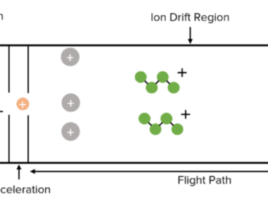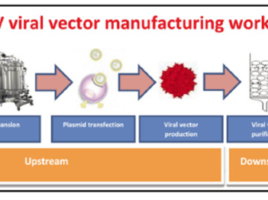
High Performance Liquid Chromatography
High-performance liquid chromatography (HPLC) (Fig.1) is a chromatographic technique that is used to separate a mixture of substances in order to identify, measure, or purify the individual components of the mixture.
How does HPLC work?
The sample combination to be separated and evaluated is placed into a stream of mobile phase percolating through a column in very small volumes (1). There are various types of columns available, each with different sorbents with variable particle sizes and surfaces (1).
The mixture interacts with the sorbent, also known as the stationary phase, as it passes through the column, each component at a different speed. The velocity of each component in the mixture is determined by 1) its chemical makeup 2) the column, and 3) the mobile phase’s composition. The retention time of a certain analyte is the time it takes for it to emerge from the column. The retention time of a certain analyte is measured under specific conditions and is used to identify the analyte (1).
Sorbent particles can be either hydrophobic or polar. Any miscible combination of water and organic solvents such as acetonitrile or methanol are regularly used mobile phases. Mobile phases that do not require water can also be used.
The mobile phase’s composition is determined by the degree of interaction between numerous sample components and the stationary phase.
Detectors
There are different types of detectors for HPLC such as UltraViolet (UV), Visible (VIS), Photodiode Array (PDA), Refractive Index, Evaporative Light Scattering, Fluorescence detectors, Electrochemical detectors and Mass Spectroscopic detectors (2).
The UV detector is a popular choice for HPLC analysis (2). During the analysis, the sample passes through a flow cell, which is a clear, colourless glass cell. When UV light is irradiated on the flow cell, a portion of the UV light is absorbed by the sample.
PDA detectors are also common and it detects the complete spectrum at the same time (2). The obtained result is visualised in two dimensions (light intensity and time) by UV and VIS detectors, but PDA adds a third dimension (wavelength) (2). It is now possible to determine the best appropriate wavelength without having to repeat analyses (2).
Advantages of HPLC
Chromatography allows for precise separation, analysis, and purification. It requires very small sample volumes (3). It can analyse drugs, food particles, plastics, pesticides, air and water samples, and tissue extracts, among other things (3).
Applications of HPLC
The HPLC process is used to identify, quantify, and purify a certain analyte or molecule. It is possible to do both quantitative and qualitative research. HPLC can be used for:
- Water purification
- Detect impurities
- Liquid-exchange chromatography
- Protein chromatography via ion exchange
- Carbohydrate and oligosaccharide anion-exchange chromatography at high pH
- Drug detection
Our HPLC training course
We offer a 3 day course, where you will learn how to set up and run the HPLC. You will also learn about sample preparation methods, HPLC method development, and how to analyse data.
This course is a great opportunity for you to learn and gain experience. For more information please click here.
References
- Thomas GP. HPLC -Methods, Benefits and Applications. (Internet) (Updated 2013 April; Cited 2022 March) Available from: https://www.azom.com/article.aspx?ArticleID=8468
- Shodex. Lesson 6: Detectors for HPLC. (Internet) (Cited 2022 March) Available from: https://www.shodex.com/en/kouza/f.html
- Cheriyedath S. Chromatography Overview. (Internet) (Cited 2022 March) Available from: https://www.news-medical.net/life-sciences/Chromatography-Overview.aspx



